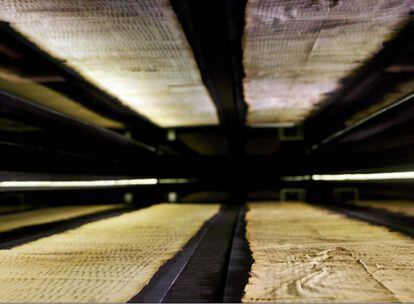Nearly 2,100 years ago, a Jewish writer ingeniously used a quill to mark the last strokes of black ink on a piece of paper. His work, a copy of the book of Isaiah from the Old Testament of the Bible, was to form, once completed, a seven-meter scroll. Now, did he complete his work or was he another writer?
Although the Dead Sea Scrolls were discovered more than 70 years ago, today’s advanced computing technologies are unlocking the secrets of the hands that wrote these famous texts. Professor Mladen Popovic of the University of Groningen in the Netherlands thinks he knows the answer.
“My idea was simply to turn to palaeontology; that is, to the font used in ancient documents,” Professor Popovich points out. Paleontology is the scientific study of ancient manuscript texts. Your goal is to determine when and where it was written. The texts typically appear on manuscripts, but are also found on ceramics, metals, textiles, and even graffiti, such as those discovered on the walls of Pompeii.
muscle movements
“The way you or I write is completely unique,” Popovich says. “It depends on muscle movement and it’s very personal.” Using artificial intelligence (AI), subject matter expert Lambert Schumaker and other members of HandsandBible project funded by Horizondeveloped new computational machine learning methods for analyzing numerically written ancient texts.
“The great thing about today’s technology is that you can create multispectral images, study pixels and then do all kinds of calculations and translate them into motion,” explains Professor Popovich. “Through their line, we can, so to speak, shake hands with them.”
The research team spent endless hours painstakingly tracing the Hebrew letters to teach a computer model what was ink and what wasn’t ink. The result was 3D models of handwritten text with more than 5,000 mathematical dimensions.
The way you or I write is completely unique, it depends on the movement of the muscles and it is a very personal thing.
Mladen Popovic, Professor at the University of Groningen
Isaiah scroll
Back in the lab in the Netherlands, Marouf Dhali, one of the team members, was baffled by the results the AI returned. According to him, about halfway through the text of the Isaiah scrolls, the writing changed enough to assume that another writer took over. This result, although statistically significant, is almost imperceptible to the naked eye.
The staff considered other options. Can he change pens? Could he have stopped writing and returned to work much later? “Although their writings are very similar, the most likely explanation is that they were two different scribes,” Popovich says. “One scribe is so skilled at imitating the other that with the naked eye the difference is indistinguishable.”
Although the academic community has debated before the possibility that the Scroll of Isaiah contained more than one writer, this is the first solid evidence for the existence of two different ones. Could AI be wrong? According to Popovich, that is less likely. To him: “A paleontologist is a lot like a black box. We don’t know exactly what’s going on in our heads. Although we’re experts at this, we can’t explain all of our paleographical thinking.”
In his view, using a computer trained on data encourages photographers to better explain their visual observations.
Time Machine
The ability to identify scribes’ personal writing and relate it to various works provides scholars with an entirely new way to engage with texts and learn about the culture of these scribes.
For example, there is Evidence that some writers are from the Dead Sea Scrolls They were only learning to write at that time. A scribe has been found producing manuscripts in Hebrew and Aramaic (an ancient language considered a lingua franca in the Middle East 2,000 to 3,000 years ago), providing new insights into his language skills.
“Another example is our approach to these clerks: is there any sign of individuality or that they have some room for maneuver?” asks Popovich. “Because there are differences, we can’t conclude that they were robotic slaves who only copied what they were asked to copy.”
Applying this ancient approach, the scroll can be considered a kind of time machine. “We can see in them a small part of the cultural development that the Bible represented,” Popovich says. It is the same cultural style for scribes. The way in which these texts were written is the same that was used two to three centuries ago.”

ancient book
the teacher Maria Chiara ScapatiquiFederico II, of the University of Naples, also turned to texts to learn more about what life was like in the ancient world. in the frame PLATINUM project funded by HorizonShe and her team traveled from Berkeley to Berlin to catalog incomplete papyrus manuscripts in Latin script from the era when Rome controlled Egypt. Between 30 BC and 641 ° C.
The team checked papyri Using techniques such as ultraviolet imaging. With this they were able to discover new texts, as well as better understand the meaning of existing texts. According to Scappaticcio, the fragments reveal a lot of information about what everyday life is like for ordinary people. The team worked on “documents between individuals relating to loaning items, letters between soldiers asking for new shoes, etc.,” he summarizes.
On the fringes of the empire, Latin was the language of power. Literature was one of Rome’s tools to impose its power
Maria Chiara Scapatichio, Professor at the Federico II University of Naples
ancient multiculturalism
In addition, these texts gave the team the opportunity to learn more about the lives of Roman Egyptians and how their identity mixed with Roman culture at the time. “Multiculturalism and multilingualism are key words for our reality,” Scapatiquio stated. “In antiquity almost the same thing happened, except for the obvious time distance.”
The research team found texts from the Aeneid, the Latin epic by Virgil that glorified the founding of Rome, which was used to teach Latin. “In the periphery of the empire, Latin was the language of power. Rome imposed its power and literature was one of the tools to achieve this,” he asserts.
In their search the team discovered the first text containing the Arabic language written in Latin script, as well as a literary work by Marco Agno Seneca (father of the Roman philosopher of the same name) believed to be completely missing. The volume of texts collected by the team in this new study is extraordinary. “In 2023 we will publish a collection containing 1,500 texts in Latin written on papyrus,” says the professor.
An earlier set, from 1958, contains only 300 texts. The goal is to allow a wider group of scholars access to written and circulating Latin works from the periphery of the Roman Empire. I hope that the use of this collection as a tool for investigating Roman Orientalism will be a starting point. It was an open society in which many aspects passed from one culture to another. It was not very different from the current situation,” explains the teacher.
The research referenced in this article was funded by the European Research Council of the European Union and the article was originally published in English horizonJournal of Research and Innovation of the European Union.
You can follow issue in FacebookAnd the Twitter And the Instagramor sign up here to receive Weekly newsletter.
Subscribe to continue reading
Unlimited reading





